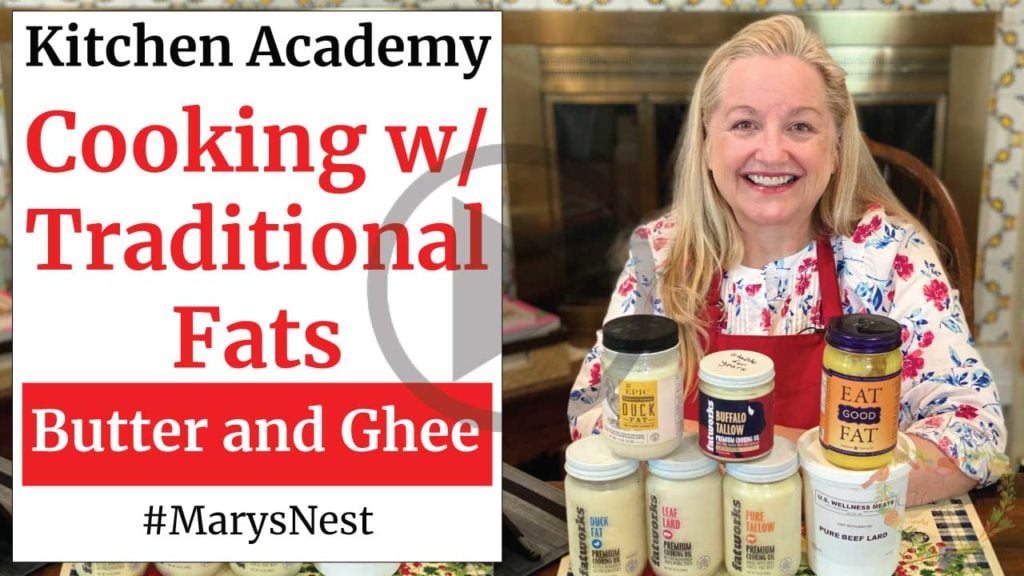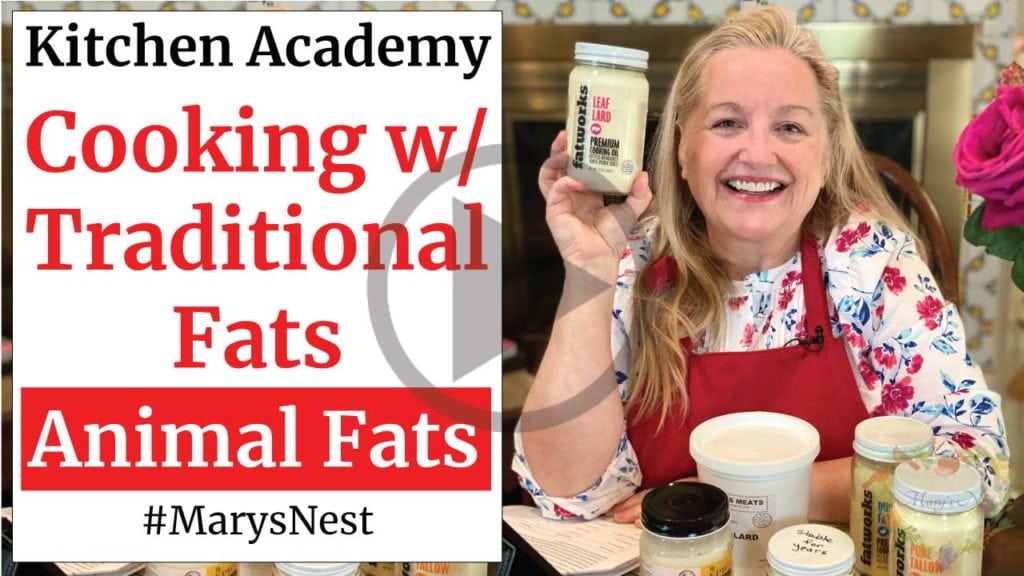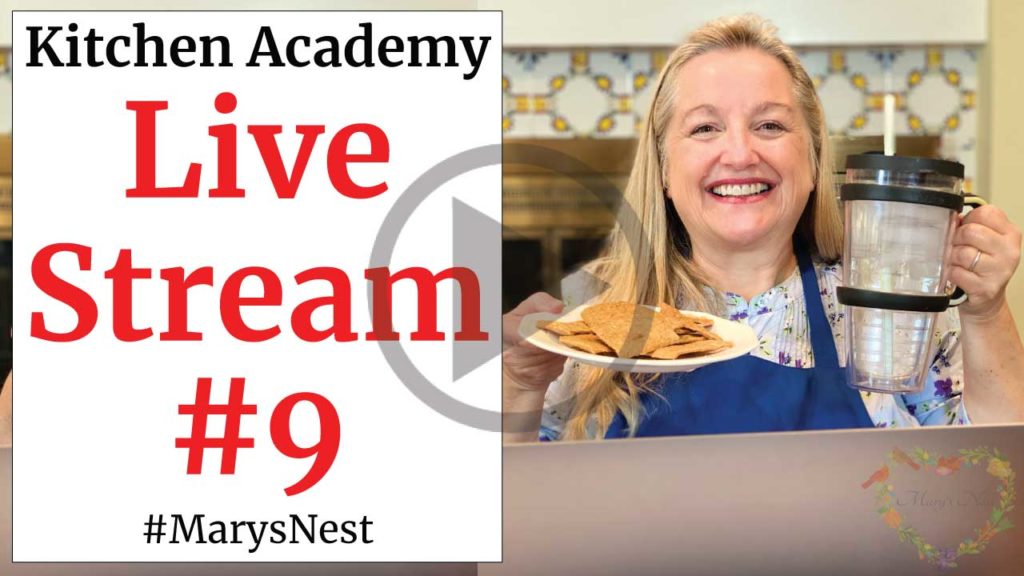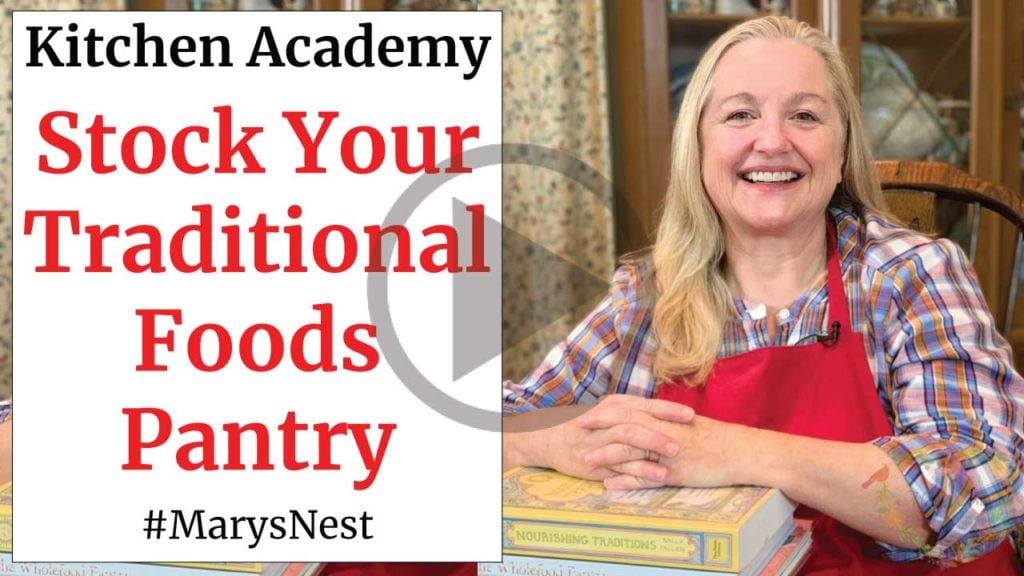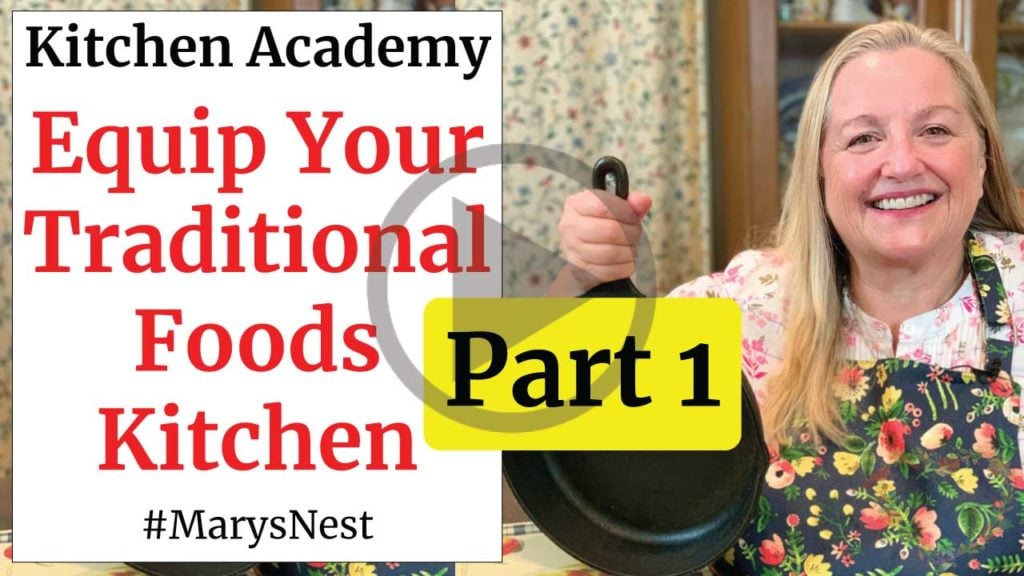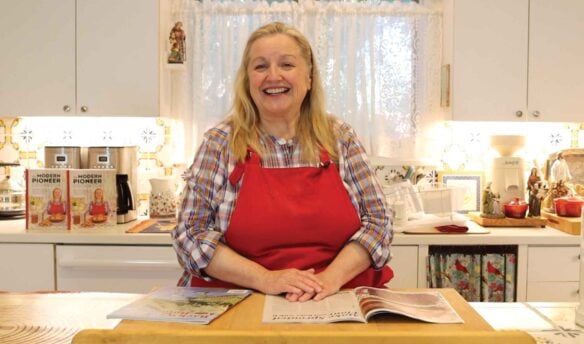Affiliates note: As an Amazon Associate I earn from qualifying purchases. My content may contain affiliate links to products and services. If you click through and make a purchase, I'll receive a small commission. It does not affect the price you pay.
The Importance of Cooking with Traditional Fats: Cooking Oils
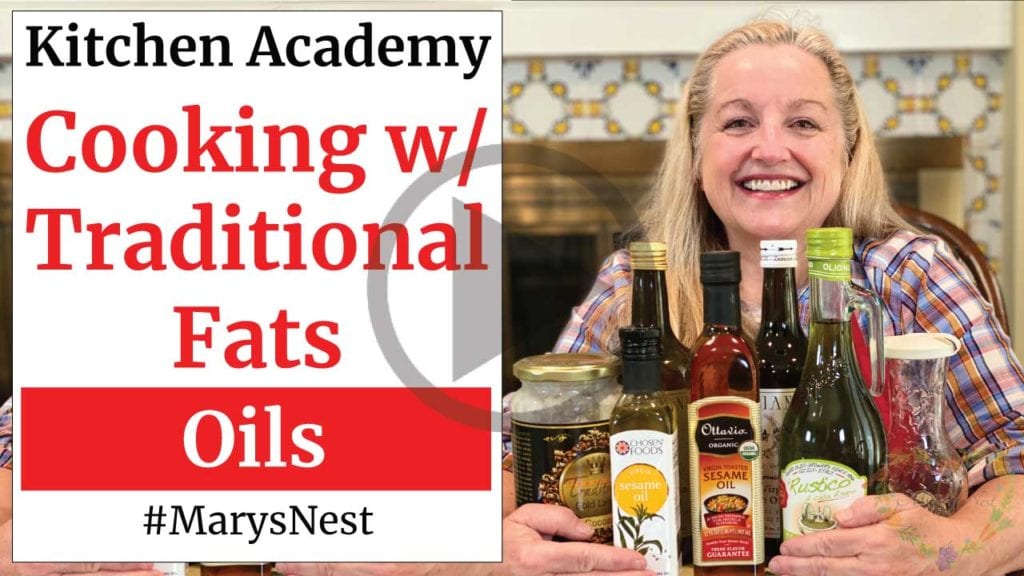
As we continue together with this series on Cooking with Traditional Fats, I want to focus on cooking oils in today’s vodcast. By cooking oils, I’m referring to those oils that are:
- Unprocessed
- Preferably cold-pressed
- Organic when possible
- And most important: Oils that have been used for centuries by traditional cultures
These conversational vodcasts are available to the Kitchen Pioneers who have joined my YouTube membership community—The Traditional Foods Kitchen Academy.
Affiliates note: As an Amazon Associate I earn from qualifying purchases. My content may contain affiliate links to products and services. If you click through and make a purchase, I’ll receive a small commission. It does not affect the price you pay.
Traditional Foods Kitchen Academy
My comprehensive vodcasts are exclusively available to members of the Traditional Foods Kitchen Academy, who we call Kitchen Pioneers. You can learn more about my optional YouTube membership community, including members-only videos and exclusive perks.
This membership community is optional. I’m still publishing my weekly detailed instructional cooking videos on my public YouTube channel that you can watch for free. (Thanks so much for being a Sweet Friend and subscriber!)
In addition to links to the latest Kitchen Academy vodcasts, this blog post lists some of the public videos that I talk about in my vodcast.
All About Cooking Oils
Before we dive into the traditional oils that I recommend using, let’s take a moment to talk about most of the oils available at our local grocery stores. In addition to the solid fats often sold for use in baking, a quick scan of the aisle reveals several types of cooking oils:
- Corn oil
- Safflower oil
- Canola oil, and
- The ambiguous vegetable oil
In addition, if you quickly glance at the packaging of any store-bought cookie, cracker, or snack package, you’ll often see an ingredient list displaying a host of other oils, including:
- Cottonseed oil, and
- The ubiquitous soybean oil
So should we be cooking with and ingesting any of these oils? That was one of the first things Sally Fallon addressed when writing her book Nourishing Traditions.
I go into a lot of detail about many of these cooking oils in today’s vodcast, but let’s suffice it to say that if you know Sally, chances are you can guess what she advises. If a cooking oil has not been used for centuries by traditional cultures, you should avoid it. These new-fangled oils are highly processed, which causes them to go rancid, and that’s why companies deodorize the highly-processed oils to disguise the rancid odor. These oils do nothing good for our bodies and can cause health problems.
To learn more about Sally’s book, be sure to watch my video where I talk about what is Nourishing Traditions.
Is Peanut Oil a Good Cooking Oil?
But what about peanut oil? Isn’t it great for frying? Well, one of the main problems with peanut oil is that it is high in the fatty acid known as Omega-6. In its unprocessed form, Omega-6 is not a bad thing, and we need this nutrient in our diet. There’s just one problem. If you eat the modern Standard American Diet (SAD – that’s right…Sad…I kid you not!) or other modern diets of the Western World, chances are you eat way too many foods that contain Omega-6.
So why is the overconsumption of Omega-6 problematic for the human body? We need a balance between the Omega-6 and Omega-3 fatty acids that we consume, along with other nutrients, to stay healthy and free of chronic illness.
But those of us who eat a modern diet often consume very few foods that contain Omega-3, so if we consume a lot of foods with Omega-6 fatty acids, we throw our diet out of balance. So, although Sally recommends that although you can use peanut oil from time to time, you should only use it infrequently and in moderation.
The Three Traditional Cooking Oils I Use
So when it comes to stocking your Traditional Foods Pantry with traditional fats—specifically oils—look to those cooking oils that have been used for a long time by traditional cultures.
Now, are there many cooking oils, including palm oil, that traditional cultures have used? Definitely! But I am going to focus on the three that I use because I have found them to agree with my palate:
- Olive Oil
- Sesame Oil
- Coconut Oil
If you’re used to eating a modern western diet, you’ll probably be attracted to the taste of these cooking oils too. I mentioned other oils earlier in this post, like palm oil, that can be healthy for you too, but they can have a strong unfamiliar taste to those of us used to the standard American diet. But should you try it? Oh yes! Because if you like it, you will be rewarded with its rich nutritional profile, including Vitamin A that supports eye health!
Olive oil
For thousands of years, many traditional cultures have used olive oil. It is tried and tested. Now, does olive oil contain Omega-6, yes? But that is OK because we need unprocessed Omega-6 in our diet. Plus, olive oil also contains Omega-3. And it is high in monounsaturated fats along with Vitamin E and K, all of which the modern western diet is in much need of.
Sesame Oil
In her book, Know Your Fats, Dr. Mary Enig discusses the fats that she recommends we include in a traditional diet. And when it comes to cooking oils, there are three that she values highly. One is olive oil, as I mentioned above, and the other two are sesame oil and coconut oil. As a matter of fact, in today’s vodcast, I share how Dr. Enig recommends making a blended oil that includes these three oils!
Dr. Enig is a fan of incorporating untoasted sesame oil in her oil blend because it is full of antioxidants. Asian cultures have used sesame oil for centuries, and we know now that it played a significant role in the health of these cultures because it is very rich in:
- Vitamin E
- Phytosterols
- Lignans
- Sesamol
- Sesaminol
These compounds help fight free radicals, which are related to the development of chronic disease. And best of all, sesame oil has a balanced ratio of omega-3 and omega-6 fatty acids!
Coconut Oil
Coconut Oil has been used by traditional cultures living in the tropics for thousands of years, so like olive oil and sesame oil, you can trust it as a traditional fat that can contribute to good health. And one of the best things about coconut oil is that it is very rich in lauric acid—just like Mother’s Milk! When a baby is born and breastfed, this essential nutrient helps boost an infant’s immune system.
Coconut oil can do the same for us as adults that Mother’s Milk does for her infant. It helps to boost our immune system! Nowadays, our bodies need this extra help to fight all of the chronic diseases, bacterial infections, and viruses that can run rampant in western cultures.
Is Avocado Oil a Good Cooking Oil?
But what about avocado oil? In her book, Nourishing Traditions, Sally Fallon does not even mention Avocado oil. How can this be? It’s the darling of the oil industry today and is often used to make mayonnaise in place of the highly-processed soybean oil.
First, let’s talk about the avocado—the actual fruit. The Aztec culture used avocados widely in Mexico for centuries. Called a vegetable butter or pear butter, the Aztecs used this avocado “butter” in much the way we would use traditional butter made from cow’s cream. The Aztecs were not extracting oil from the actual avocado. They simply ate the avocado as is.
When Sally Fallon wrote her chapter on fats in Nourishing Traditions, she doesn’t even mention avocado oil. Why? Because avocado oil is a relatively new innovation, particularly as a culinary oil!
In 1918, the British Imperial Institute experimented with the possibility of extracting oil from the avocado pulp. Was it a success? No one knows for sure because it is unclear as to recorded history as to what happened. However, in 1934 in California, the State Chamber of Commerce observed that some companies were using avocados, unfit for sale, for oil extraction.
This extraction of oil opened the door to the idea of using damaged avocados for their oil. This type of oil could be used not for culinary purposes, but instead for cosmetics, among other things. And chances are, most of us would not have wanted to ingest that version of avocado oil since the extraction processes involved high heat and chemical solvents. Surely, it was damaged in the process!
New cold press method for making Avocado oil
It wasn’t until the late 1990’s that a new cold press method for extracting avocado oil was developed in New Zealand. Finally, it was this process that allowed avocado oil to be used for culinary purposes.
So what are Sally’s thoughts on avocado oil? Although avocados are high in nutrition and wonderful for us to eat, is the oil extracted from the avocado something we should ingest on a regular basis? In its extracted form, avocado oil can’t be considered a traditional oil, but that doesn’t necessarily mean it is bad for us.
And what about all those other new oils, including:
- Grape seed oil
- Rice bran oil
- Hemp seed oil
- Argan oil
- And more!
To learn more about Sally’s thoughts on all these oils, including avocado oil, be sure to read her discussion about this timely topic:
Other Traditional Fats
My latest vodcast on cooking oils rounds out my special series on the importance of cooking with traditional fats. Don’t miss the other two videos in this series covering:
More Kitchen Pioneer Videos
Catch up on some of the videos that you may have missed in our membership community:
- Traditional Foods Kitchen Academy video playlist (Optional Membership Community)
Remember that you’re always welcome to post questions and comments on my videos at any time, and I’m glad to reply.
Stay in Touch with Mary’s Nest
- Subscribe to My YouTube Channel for Traditional Foods Videos (Free) - When you subscribe, be sure to click on the notification bell that will let you know each time I upload a new video.
- Subscribe to Mary’s Traditional Foods Newsletter (Free) - Get a free 36-page eBook for signing up: How to Stock Your Essential Traditional Foods Four-Corners Pantry.
- Join the Traditional Foods Kitchen Academy - For more detailed videos and exclusive members-only perks, join my YouTube membership community.
- Order The Modern Pioneer Cookbook - Get a printed book of Mary's nourishing recipes from a Traditional Foods Kitchen. This bestselling cookbook is published by Penguin Random House with their DK imprint.
I look forward to having you join me in my Texas Hill Country Kitchen!
Shop for items used in this blog post or video
Favorite Kitchen Supplies
- Chef’s Knife
- Bamboo Cutting Board
- Lodge Cast Iron Frying Pan
- Scanpan
- Spatula Spoon
- Whisk
- Large Stock Pot
- Stainless Steel Colander
- Large Measuring Cup
- Stainless Steel Measuring Cups and Spoons
- Baking Sheet
- 2-Cup Glass Storage Jars with Lids
- 10-Piece Glass Bowl Set
- Flour Sack Towels
- Fat Separator
- Favorite Aprons
In addition, the following links and promo codes will help you save on fermentation supplies, grain grinders, and whole grains.
- Masontops Fermentation Kit (See promocode below)
- Mockmill Grain Grinder and Whole Grains (promo code below)
Use promo code MARYSNST for a one-time 15% off Masontops and Breadsmart products on Amazon.com.
Learn more about Mockmill electric grain mills for making fresh flour and their Flake Lover's Flaker that flakes whole grain in minutes.
Amazon Shop and Shopping Guide
- Visit Mary’s Nest Amazon Shop
- Visit my Shopping Guide page
Get up to 15% off for stocking your Traditional Foods Pantry and equipping your Modern Pioneer Kitchen, including discounts from US Wellness Meats, Farmhouse Teas, Lehman's, Masontops, Cultures for Health, Survival Garden Seeds, Redmond Real Salt, Plan to Eat, and More!
Recommended Reading
Disclaimer:I am not a medical doctor, a medical professional, a dietician, or a nutritionist. All content found on the MarysNest.com website, including text, images, videos, eBooks or eGuides, social media, or other formats, were created solely for informational purposes only. The content is not intended to be a substitute for professional medical advice, diagnosis, or treatment. Always seek the advice of your physician or other qualified healthcare provider with any questions you may have regarding a medical condition or proper nutritional advice. Never disregard professional medical advice or delay in seeking it because of something you have watched in a video or read on this website. Use caution when following the recipe in this video. The creator and publisher of this video and website will not be held responsible for any adverse effects that may arise from the use of this recipe and method or any other recipe and method on this website or corresponding video channel.

